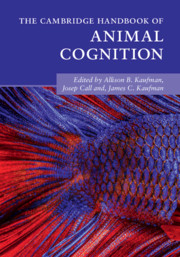Book contents
- The Cambridge Handbook of Animal Cognition
- The Cambridge Handbook of Animal Cognition
- Copyright page
- Dedication
- Contents
- Figures, Tables, and Boxes
- Contributors
- Acknowledgments
- Introduction
- Part I Communication and Language
- Part II Memory and Recall
- 6 Memory and Recall Overview
- 7 A Fish Memory Tale
- 8 Memory in Hummingbirds
- 9 Event Memory in Rats
- 10 Primate Recall Memory
- Part III Social Cognition
- Part IV Social Learning and Teaching
- Part V Numerical and Quantitative Abilities
- Part VI Innovation and Problem-Solving
- Index
- References
10 - Primate Recall Memory
from Part II - Memory and Recall
Published online by Cambridge University Press: 01 July 2021
- The Cambridge Handbook of Animal Cognition
- The Cambridge Handbook of Animal Cognition
- Copyright page
- Dedication
- Contents
- Figures, Tables, and Boxes
- Contributors
- Acknowledgments
- Introduction
- Part I Communication and Language
- Part II Memory and Recall
- 6 Memory and Recall Overview
- 7 A Fish Memory Tale
- 8 Memory in Hummingbirds
- 9 Event Memory in Rats
- 10 Primate Recall Memory
- Part III Social Cognition
- Part IV Social Learning and Teaching
- Part V Numerical and Quantitative Abilities
- Part VI Innovation and Problem-Solving
- Index
- References
Summary
Many studies have documented the types of memory evident in nonhuman primates.These range in time scales of remembering for seconds to remembering for minutes or even years. An important distinction in human memory is between recognition and recall modes of remembering. Recognition occurs when an external cue aids in memory performance, where the cue evokes the memory. Recall, however, requires a more spontaneous and internally driven memory process. In humans, recall typically is seen when people report experiences verbally, without need of specific cues. This is more difficult to demonstrate in nonhuman animals but can be done if a test can be used that provides no specific, recognizable cues included in the assessment of what is remembered. Some of those tests, as given to different nonhuman primate species, are outlined in this chapter. The resulting data indicate that nonhuman primates do engage in memory recall without the need of external cues, and the implications of this reflect another commonality in the cognitive systems of humans and other animals.
- Type
- Chapter
- Information
- The Cambridge Handbook of Animal Cognition , pp. 210 - 222Publisher: Cambridge University PressPrint publication year: 2021



